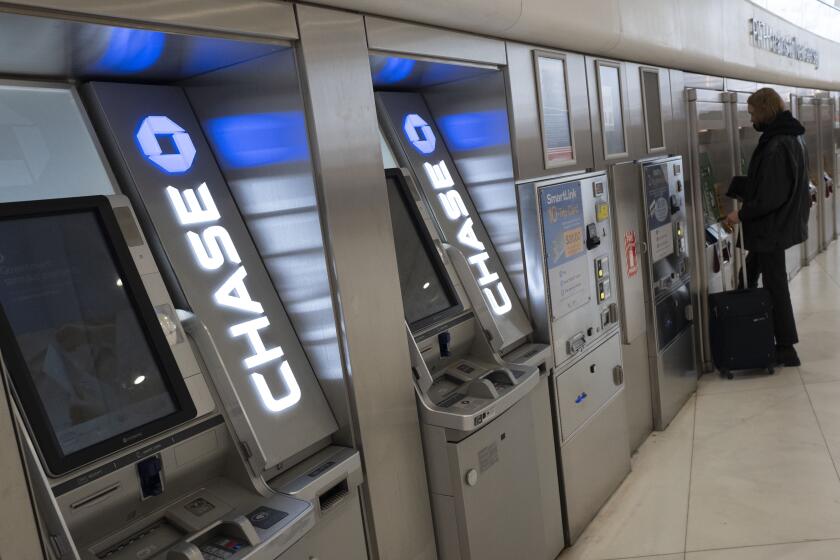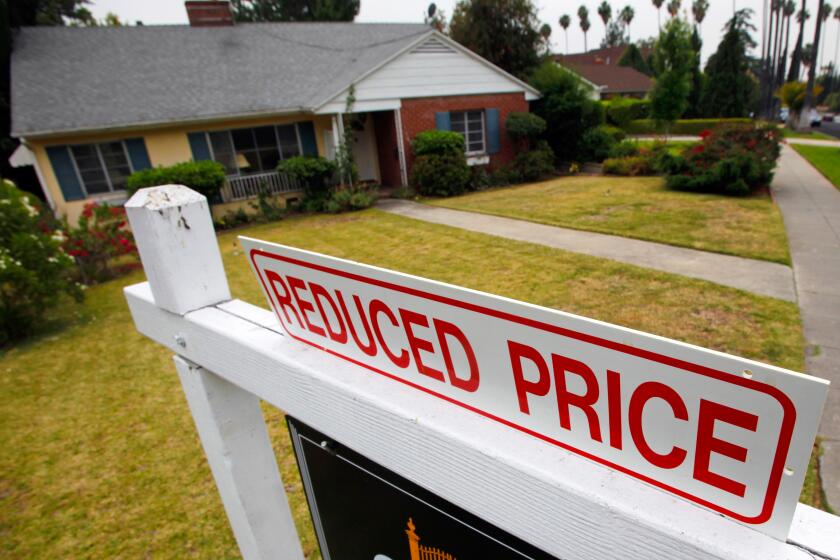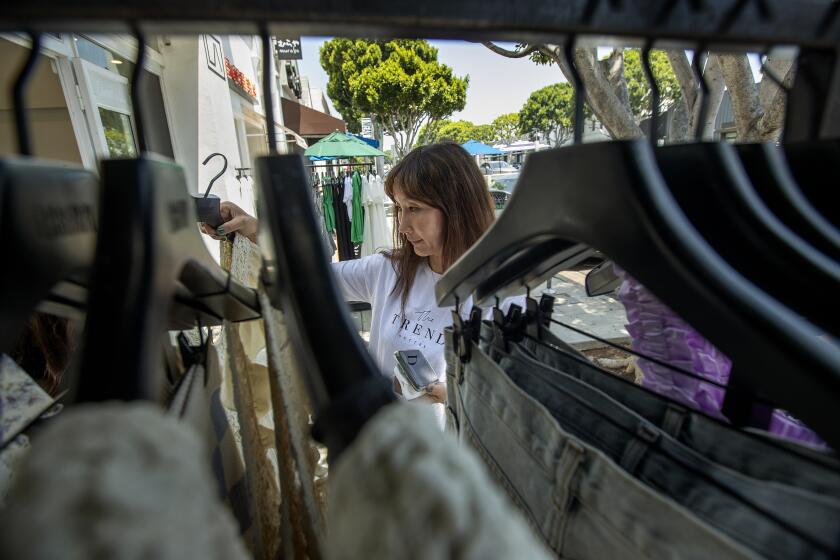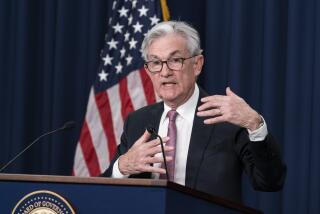With a big rate hike, the Fed hopes to slow, but not stifle, the economy
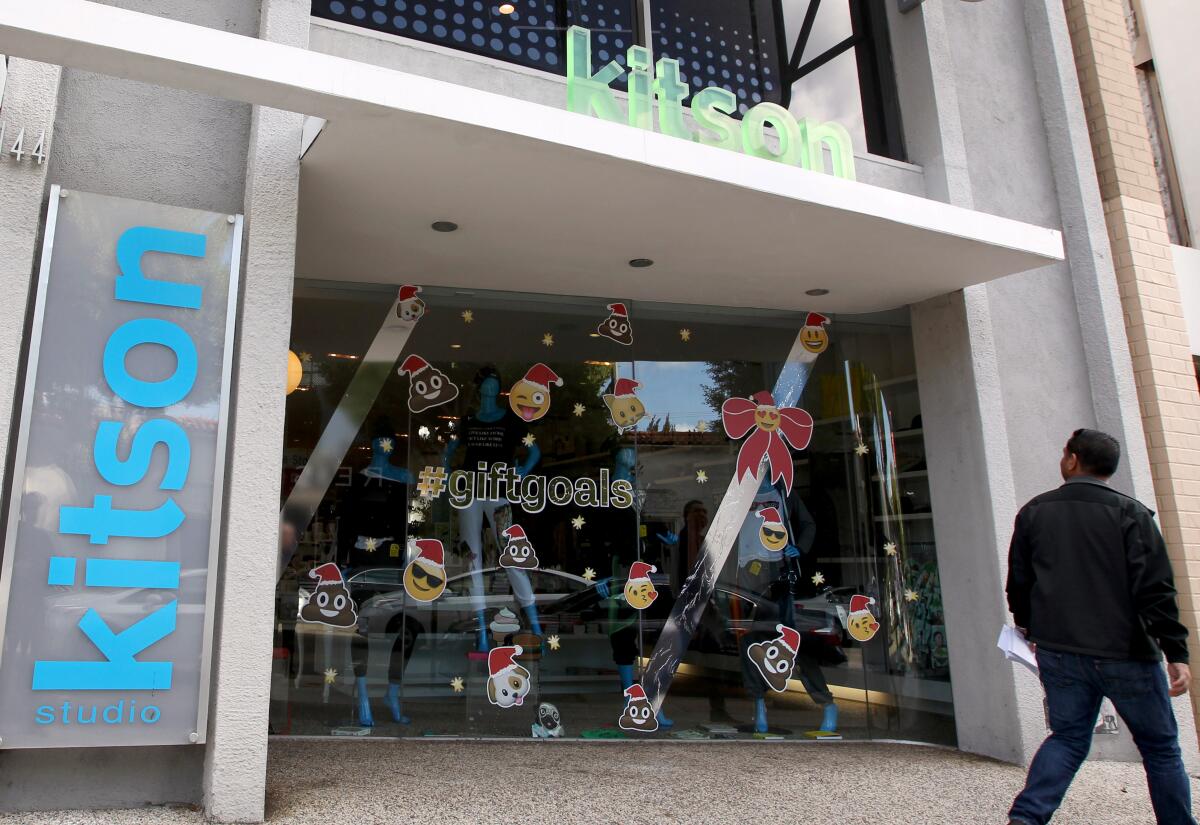
- Share via
Just a month ago, the Federal Reserve raised interest rates by half a percentage point for the first time in 22 years as it stepped up its attack on accelerating inflation.
On Wednesday, the U.S. central bank raised rates by an additional three-quarters of a percentage point. It hadn’t done that in 28 years since the advent of the first tech boom, reflecting a widespread sense that inflation is out of control — and, some say, beyond its control, having hit a 40-year high.
The Russian invasion of Ukraine has exacerbated inflation at the grocery store. At the pumps, the conflict has driven average Los Angeles gas prices to $6.44 a gallon for regular. Lingering pandemic-related supply snarls have caused a chip shortage and sticker shock in auto showrooms. And a nationwide housing shortage particularly acute in California has seen prices skyrocket in markets as far-flung as Boise, Idaho.
Fed Chair Jerome H. Powell had signaled in May that additional half-point hikes were likely at the bank’s policy meetings this month and again in July as it sought to rein in inflation without causing a recession — a so-called soft landing. But since then, the notion that inflation was under control fell apart.
The government’s latest inflation report Friday showed that consumer prices in May rose 8.6% year over year, the highest level since December 1981. The stunning figures sent the crypto and stock markets into a tailspin, with the Dow sinking nearly 900 points Monday and the Standard & Poor’s 500 falling into bear market territory, more than 20% off its peak. Powell said the report influenced the bank’s decision.
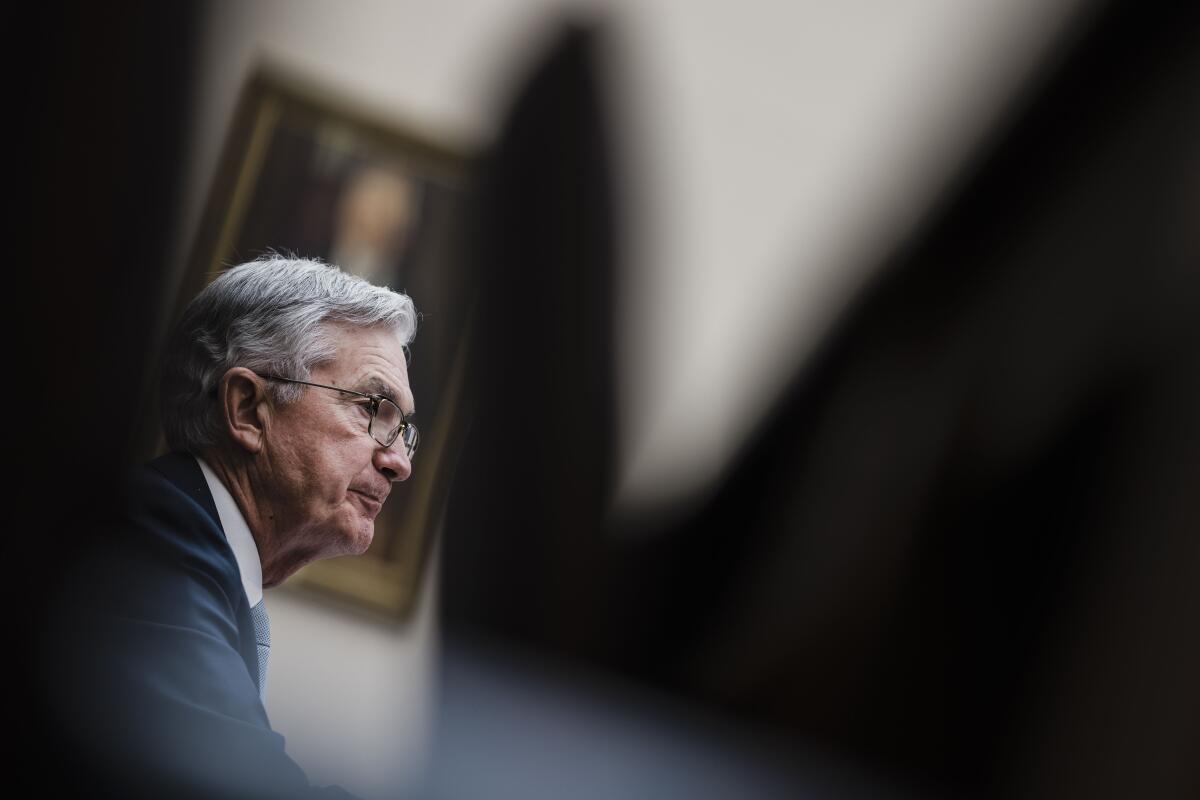
“Given last Friday’s very ugly inflation report, they are stepping hard on the brakes,” said Mark Zandi, chief economist at Moody’s Analytics. “Broadly, they want to raise rates fast enough and high enough to slow the economy’s growth and quell inflation but not too far, too fast so it pushes the economy into a recession — and that’s a very thin needle to thread.”
Wednesday’s action brought the federal funds target range — which serves as a peg for what large commercial banks charge one another for overnight loans and influences a wide swath of business and consumer loans — to 1.5% to 1.75% as the central bank seeks to bring inflation back to its target rate of 2%.
Consumers already paying more for gas, groceries and everyday items should expect higher prices in other parts of their lives after the Fed rate increase.
Powell said the Fed is now targeting a federal funds rate of 3% to 3.5% by the end of this year and 3.8% to 4% next year — with an increase of 50 to 75 basis points on the table at its next meeting. Along the way, the bank expects the unemployment rate will rise from 3.6% in May to 3.9% next year and 4.1% in 2024. (The federal funds rate had been at 0% to 0.25% in 2020, cheap money meant to restart the economy amid the pandemic.)
“We’ve been expecting progress and we didn’t get that. We got sort of the opposite,” Powell said, noting that the war has driven up commodity prices, something beyond the control of the central bank, causing inflation rates even higher in other countries. “It’s a very difficult situation to be in.”
Investors responded positively to the Fed’s action, with the Dow Jones industrial average closing up 1% at 30,668.53. The Standard & Poor’s 500 rose about 1.5% to 3,789.99, and the tech-heavy Nasdaq composite beat the other indexes with a 2.5% gain to 11,099.15.
Some economists thought the Fed could have gone even higher than its three-quarter-point increase, though it would have been bitter medicine indeed, driving credit card rates, car loans, home equity loans and home mortgages even higher.
“Even with a 75-basis-point increase in the interest rates, the U.S. Fed is way behind the curve in tackling inflation. An interest rate hike of 100 basis points would have been ideal, and a slower rate hike than this would mean that the Fed will continue feeding into inflation,” said Willem H. Buiter, an adjunct professor at Columbia University and former member of the Bank of England’s monetary policy committee.
This means, Buiter said, the Fed should target raising the federal funds rate to 5% by the end of this year as it seeks to bring down inflation.
Economists point out that the Fed move, although significant because of the size of the rate boost, also comes in very unique circumstances that influence how the hike will ripple across consumer behavior and the broader economy.
Interest rate changes typically affect consumer demand slowly, Buiter said, and they could take even longer than usual to cool the economy now, because pent-up demand from the pandemic is still driving consumer spending — what some are calling “revenge spending” after lockdowns and restrictions.

“We are coming into this with a very different economic environment,” said Leo Feler, senior economist at the UCLA Anderson Forecast. “It might take longer now because people have so much pent-up savings.”
The Fed’s decision is likely to increase rates on adjustable-rate mortgages, but the effect is less clear for fixed-rate mortgages such as the popular 30-year fixed loan, which bakes in rising inflation.
The 30-year mortgage rose from around 3% in January to above 5% last week. By some measures, rates even topped 6% as of Monday. The sharp rise in borrowing costs has caused some home buyers to think smaller and priced others out of the market altogether, causing home sales to fall.
In a significant shift in the market, fewer homes are going into escrow, inventory is rising and sellers are increasingly cutting their asking prices.
With less demand, more home sellers are dropping their asking prices, and the real estate industry itself is starting to feel the effects. On Tuesday, real estate brokerages Redfin and Compass announced they were laying off 8% and 10% of their workforces, respectively.
For months, mortgage lenders have also shed staff, including companies such as Wells Fargo and Mr. Cooper. As the housing market slows, more losses could be on the way.
“I speak to so many CEOs and they are all saying the same thing,” said David Stevens, chief executive of Mountain Lake Consulting and former head of the Mortgage Bankers Assn. “They are going to have to right-size their companies.”
Credit card rates also will rise because they are tied to the prime rate charged by banks to their best customers, a rate that is itself linked to the federal funds rate.
Having to deal with a big rise in credit card rates, after the pandemic, lockdowns, the loss of tourism and supply-chain woes, is like having “another survival challenge,” said Fraser Ross, owner of the Kitson clothing and accessories stores in Los Angeles and Pacific Palisades.
Over the years, Kitson made a name for itself as a tastemaker, discovering and launching new brands that became trendsetters. But it’s a more difficult business now, and higher credit card rates for customers won’t help.
“You can’t plan your business six months out anymore. It’s more like six weeks,” Ross said. “You have to chase your customers now with the top sellers that people will want no matter what. They’re always going to have to buy for the new baby, so we’re going to be pushing those things. People are not going to stop buying birthday presents. But are they going to buy that cashmere sweater for $400? No.”
Early this month, the quarterly UCLA Anderson Forecast — citing the war, COVID-19 lockdowns in China, supply-chain constraints and inflation — predicted the economy will slow in California and across the nation but not fall into a recession, with U.S. economic growth hitting 2.8% this year and falling to 2% next year.
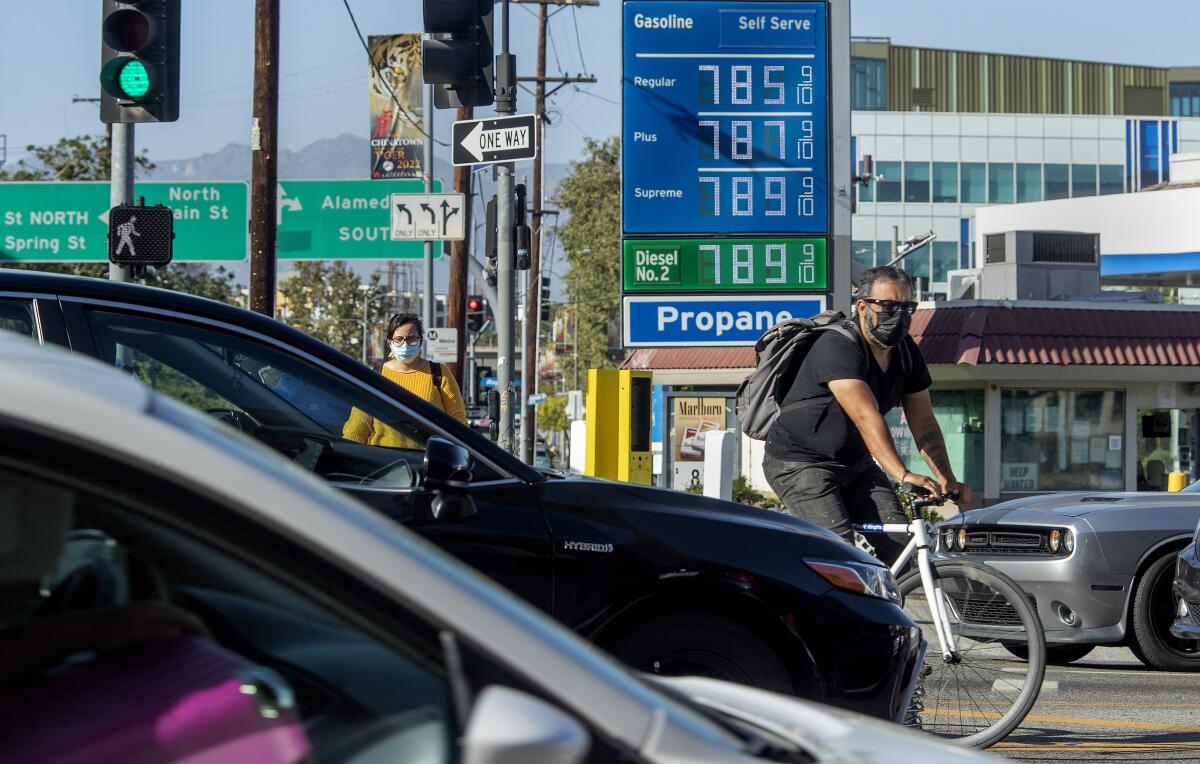
Forecast Director Jerry Nickelsburg said that although the policy is to not tweak the forecast between quarters, he acknowledged there has been “increased uncertainty about the economy” since it was issued just two weeks ago.
“So the Federal Reserve is trying to figure out how to use interest rates to cool demand for housing and cars without sending the economy into a tailspin, and there’s no magic formula for doing that,” he said.
The economy added 390,000 jobs in May, more than many analysts expected. However, there have been growing numbers of layoffs in Silicon Valley and the broader tech industry as weak startups falter. Now, with interest rates rising, there isn’t cheap money to prop them up. Layoffs and slowdowns in hiring have even affected big names such as Meta, Twitter and Netflix and prominent startups such as Carvana and Robinhood.
Residents of the Los Angeles area are changing how they eat, shop and do business to cope with some of the nation’s highest gas and housing prices.
Nickelsburg said that although the California tourism industry is still suffering from pandemic-related travel restrictions and rising gas prices could discourage out-of-state visitors this summer, the state is well-positioned to withstand economic shocks, with Sacramento having access to a rainy day fund and a large budget surplus.
California also will benefit from federal spending on infrastructure and defense, and the continuing backlog at its ports means the logistics industry should continue hiring. Although housing costs will rise, he said, the state’s overheated real estate market can withstand it.
Sellers of single-family homes may get two offers instead of 10, he said, while multifamily building will remain strong. “Interest rates are not as important in these circumstances than if you had lower occupancy and kind of squishy rental rates,” he said.
Nevertheless, rising inflation has given reign this month to rising anxiety, with billionaire entrepreneur Elon Musk saying he had a “super bad feeling” about the economy and JPMorgan Chase Chairman Jamie Dimon telling investors to prepare for an economic “hurricane” because of interest rate increases and Russia’s war in Ukraine.
The crash in the cryptocurrency and stock market, which has given back all the gains of the Biden administration, has done little to quell those feelings — with the realization dawning that much of those gains may have been artificially driven by $5 trillion in pandemic-related government spending, leading to the crypto surge, meme-stock phenomenon and excesses in the now-collapsed market for SPACs, or special purpose acquisition companies.
Nevertheless, not all asset managers and investors are predicting the worst.
George Ball, chairman of Sanders Morris Harris, a Houston investment firm with $4.9 billion in assets under management, said investors who have been in the market for years are still showing large gains — and can withstand further drops in the market. The S&P 500 is down about 1,000 points from the start of the year.
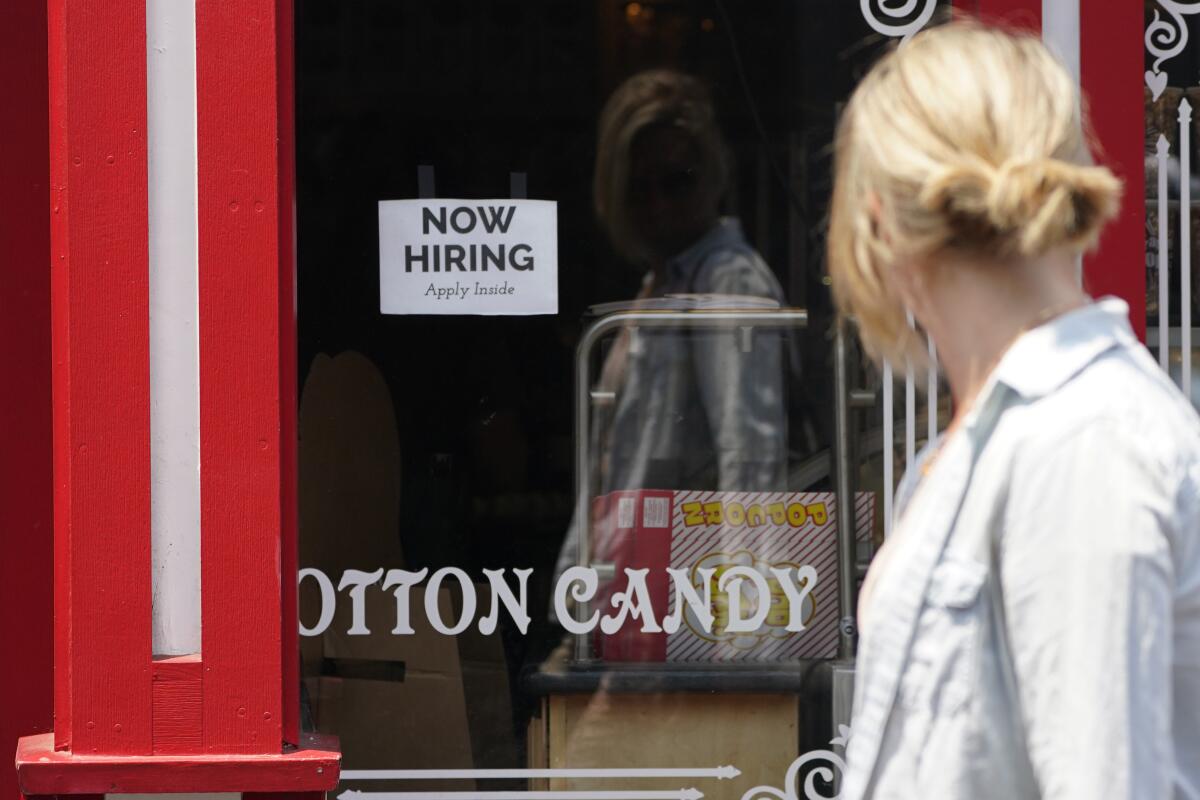
“I spoke with one sophisticated investor yesterday, who was bemoaning all the money that his institution had lost this year — and they’re still up 80% over the last four years. People just don’t feel good about things,” he said. “However, the force 4 hurricane that some prognosticators anticipate is very unlikely to happen. It’s going to be something between a tropical storm and a tropical depression. A drop in the S&P to 3,300 would not be either unlikely nor a calamity.”
Still, key for the Fed, the market and economy will be turning around consumer sentiment, which affects spending and has quickly soured. U.S. consumer sentiment plunged in early June to the lowest on record as soaring inflation continued to batter household finances.
The University of Michigan’s preliminary June sentiment index fell to 50.2 from 58.4 in May, weaker than all estimates in a Bloomberg survey of economists that had a median forecast of 58.1.
Inflation expectations, which the Federal Reserve watches closely, also moved higher, and 46% of respondents attributed their negative views to persistent price pressures. Just 13% expect their incomes to rise more than inflation, the lowest share in almost a decade.
Powell acknowledged that the recent figures on inflation and consumer sentiment played a role in persuading the bank’s policy committee to more sharply raise interest rates, which he said was unusual given how close they came to the meeting. “It was quite eye-catching,” he said of the sentiment data.
Zandi said the three-quarter-point increase in the federal funds rate indicates the Fed is scrambling to get on top of all this, but the move in itself is likely to “raise angst and make people nervous and more likely to pull back and that’s a recession.”
“They don’t have a script. They’re now kind of doing things ad hoc, and that doesn’t give me a warm, fuzzy feeling,” he said.
Times staff writers Andrew Khouri and Ronald D. White and Bloomberg News contributed to this report.
More to Read
Inside the business of entertainment
The Wide Shot brings you news, analysis and insights on everything from streaming wars to production — and what it all means for the future.
You may occasionally receive promotional content from the Los Angeles Times.
